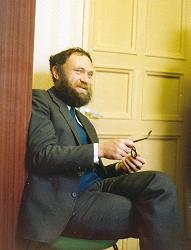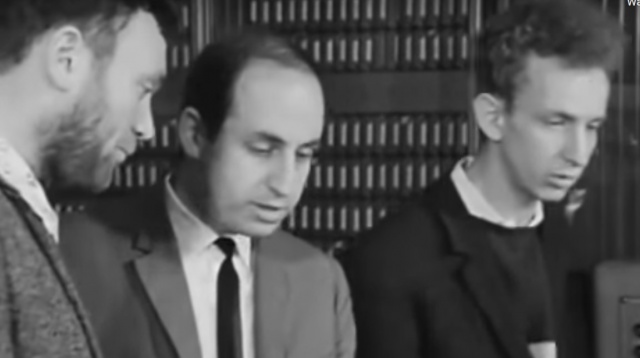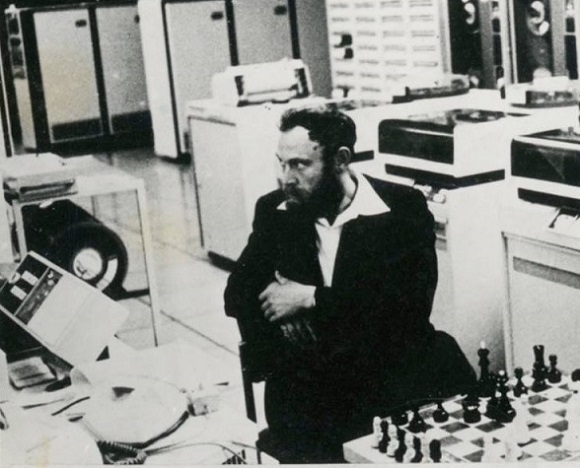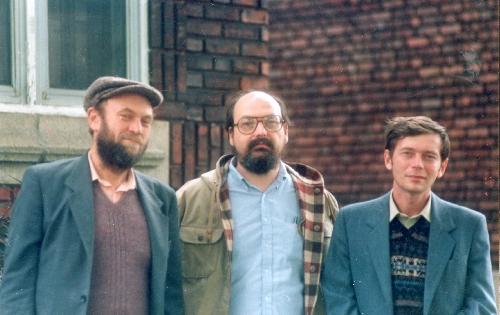Difference between revisions of "Vladimir Arlazarov"
(→External Links) |
|||
| Line 57: | Line 57: | ||
* [http://schools.keldysh.ru/uvk1838/Sciper/volume1/cognitiv.htm Vladimir Arlazarov at Cognitive Technologies] | * [http://schools.keldysh.ru/uvk1838/Sciper/volume1/cognitiv.htm Vladimir Arlazarov at Cognitive Technologies] | ||
* [http://www.mathnet.ru/php/person.phtml?personid=24727&option_lang=eng Arlazarov Vladimir L'vovich] from [http://www.mathnet.ru/php/person.phtml?option_lang=eng Math-Net.Ru] | * [http://www.mathnet.ru/php/person.phtml?personid=24727&option_lang=eng Arlazarov Vladimir L'vovich] from [http://www.mathnet.ru/php/person.phtml?option_lang=eng Math-Net.Ru] | ||
| + | * [http://www.mathnet.ru/php/archive.phtml?wshow=paper&jrnid=vyuru&paperid=538&option_lang=rus Vladimir Arlazarov is 80 years old] | ||
* [https://en.wikipedia.org/wiki/Method_of_Four_Russians Method of Four Russians from Wikipedia] | * [https://en.wikipedia.org/wiki/Method_of_Four_Russians Method of Four Russians from Wikipedia] | ||
* [http://patents.justia.com/patent/5799276 US Patent for Knowledge-based speech recognition system and methods having frame length computed based upon estimated pitch period of vocalic intervals Patent (Patent # 5,799,276 issued August 25, 1998)] by [[Edward Komissarchik]], [[Vladimir Arlazarov]], [[Michael G. Malkovsky]], et al. | * [http://patents.justia.com/patent/5799276 US Patent for Knowledge-based speech recognition system and methods having frame length computed based upon estimated pitch period of vocalic intervals Patent (Patent # 5,799,276 issued August 25, 1998)] by [[Edward Komissarchik]], [[Vladimir Arlazarov]], [[Michael G. Malkovsky]], et al. | ||
* [http://acm.mipt.ru/twiki/bin/view/Algorithms/ArlazarovChessAlgo#_niq_k_o___cjoc_p_j_r_qi_coo Владимир Арлазаров: «Алгоритмы шахматных программ »] (Algorithms of chess programs) | * [http://acm.mipt.ru/twiki/bin/view/Algorithms/ArlazarovChessAlgo#_niq_k_o___cjoc_p_j_r_qi_coo Владимир Арлазаров: «Алгоритмы шахматных программ »] (Algorithms of chess programs) | ||
| + | * [https://nauka.tass.ru/nauka/7020044 Ученый рассказал, почему советские компьютерные шахматы не повторили успех "Тетриса"] (The scientist explained why the Soviet computer chess did not repeat the success of "Tetris"), 2019 | ||
* [https://arzamas.academy/materials/2233 Владимир Арлазаров: «Игры помогли нам понять, как человек решает трудные логические задачи»] (Games helped us understand how a person solves difficult logical problems) [https://en.wikipedia.org/wiki/Arzamas_(website) Arzamas website], 2021 | * [https://arzamas.academy/materials/2233 Владимир Арлазаров: «Игры помогли нам понять, как человек решает трудные логические задачи»] (Games helped us understand how a person solves difficult logical problems) [https://en.wikipedia.org/wiki/Arzamas_(website) Arzamas website], 2021 | ||
| + | * [https://stimul.online/articles/interview/ot-kaissy-do-rossiyskogo-pasporta/ От «Каиссы» до российского паспорта] (From "Kaissa" to the Russian passport), 2021 | ||
=References= | =References= | ||
Revision as of 12:56, 15 August 2021
Home * People * Vladimir Arlazarov
Vladimir L’vovich Arlazarov,
a Russian mathematician, computer scientist, computer chess pioneer, and CEO of the private company Cognitive Technologies [3] [4] [5] founded in 1993, located in the building of the Institute of Systems Analysis, Russian Academy of Sciences, Moscow [6] [7]. Since 2007, Vladimir Arlazarov is member of the European Academy of Sciences [8].
In 1963 [9] at Alexander Kronrod’s laboratory at the Moscow Institute of Theoretical and Experimental Physics (ITEP), Vladimir Arlazarov co-developed the ITEP Chess Program, along with Georgy Adelson-Velsky, Anatoly Uskov and Alexander Zhivotovsky, advised by Russian chess master Alexander Bitman and three-time world champion Mikhail Botvinnik [10]. At the end of 1966 a four game match began between the Kotok-McCarthy-Program, running on a IBM 7090 computer, and the ITEP Chess Program on a Soviet M-20 computer. The match played over nine months was won 3-1 by the The ITEP program, despite playing on slower hardware. By 1971, Mikhail Donskoy joined with Arlazarov and Uskov to program its successor on an ICL System 4/70 at the Institute of Control Sciences, called Kaissa, which became the first World Computer Chess Champion in 1974 in Stockholm.
Contents
Photos
ITEP Chess Program
Vladimir Arlazarov, Alexander Bitman and Alexander Zhivotovsky, ITEP, November 24, 1967 [11]
Kaissa
Kaissa on an ICL 4/70 operated by Vladimir Arlazarov during the WCCC 1974 [12]
Thompson and Donskoy
Vladimir Arlazarov, Ken Thompson and Mikhail Donskoy, 1992 [13]
Selected Publications
1968
- Vladimir Arlazarov, Alexander Bitman (1968). Will the machine beat man? Shakhmaty v SSSR, 2, 9–11
1970 ...
- Vladimir Arlazarov, E. A. Dinic, M. A. Kronrod, I. A. Faradzhev (1970). On economical construction of the transitive closure of a directed graph. Doklady Akademii Nauk (in English) 194, No. 11, 1209-1210 [18] [19] [20]
- Vladimir Arlazarov (1970). Programming Chess. Uspechi Matematiczeskich Nauk
- Georgy Adelson-Velsky, Vladimir Arlazarov, Alexander Bitman, Alexander Zhivotovsky, Anatoly Uskov (1970). Programming a Computer to Play Chess. Russian Mathematical Surveys, Vol. 25, pp. 221-262.
- Vladimir Arlazarov, I. I. Zujev, Anatoly Uskov, I. A. Faradzhev (1974). An algorithm for the reduction of finite non-oriented graphs to canonical form. U.S.S.R. Computational Mathematics and Mathematical Physics, No. 14
1975 ...
- Georgy Adelson-Velsky, Vladimir Arlazarov, Mikhail Donskoy (1975). Some Methods of Controlling the Tree Search in Chess Programs. Artificial Intelligence, Vol. 6, No. 4, pp. 361-371. ISSN 0004-3702. Reprinted (1988) in Computer Chess Compendium pp. 129-135. [21]
- Georgy Adelson-Velsky, Vladimir Arlazarov, Mikhail Donskoy (1977). On the Structure of an Important Class of Exhaustive Problems and Methods of Search Reduction for them. Advances in Computer Chess 1
- A. G. Alexandrov, Vladimir Arlazarov, A. M. Baraev, Ya. Yu. Gol'fand, V. N. Deza, T. P. Il’ina, Edward Komissarchik, Anatoly Uskov, I. A. Faradzhev, Aaron L. Futer (1977). Processing of large files of information on the example of the analysis of the rook’s end game. Programming and Computer Software, No. 3
- Vladimir Arlazarov, Aaron L. Futer (1979). Computer Analysis of a Rook End-Game. Machine Intelligence 9 (eds. Jean Hayes Michie, Donald Michie and L.I. Mikulich), Ellis Horwood, Chichester. Reprinted in Computer Chess Compendium
- Georgy Adelson-Velsky, Vladimir Arlazarov, Mikhail Donskoy (1979). Algorithms of adaptive search. Machine Intelligence 9 (eds. Jean Hayes Michie, Donald Michie and L.I. Mikulich), pp. 373-384. Ellis Horwood, Chichester.
1980 ...
- Georgy Adelson-Velsky, V. P. Akimov, Vladimir Arlazarov (1981). On a probabilistic approach tо verification of the Shannon game model. Avtomatika i Telemekhanika, No. 9, 138–144
- Г.М. Адельсон-Вельский, В.Л. Арлазаров, А.Р. Битман, М.В. Донской (1983). Машина играет в шахматы, pdf (book with detailed explanations of Kaissa algorithms, language: Russian)
- Georgy Adelson-Velsky, Vladimir Arlazarov, Mikhail Donskoy (1988). Algorithms for Games. Springer
2000 ...
- Vladimir Arlazarov, M. D. Kazanov (2008). Segmentation of small objects in color images. Programming and Computer Software, Vol 34, No. 3
2010 ...
- Vladimir Arlazarov, O. A. Slavin, A. G. Khovanskii (2011). Estimation of the distance between images under translation. Doklady Mathematics, Vol. 83, No. 2
- Gennady V. Ponomarev, Vladimir Arlazarov, Mikhail S. Gelfand, Marat D. Kazanov (2014). ANA HEp-2 cells image classification using number, size, shape and localization of targeted cell regions. Pattern Recognition, Vol. 47, No. 7, pdf
See also
- ITEP Chess Program Video, 1967
- Scotch versus Vodka - one of David Levy's bets
Forum Posts
- Early Reference on Bit-Boards by Tony Warnock, rgc, October 29, 1994
- Kaissa & Botvinik by Shay Bushinsky, rgcc, October 16, 1997
External Links
- Vladimir Arlazarov from Wikipedia
- Vladimir Arlazarov's ICGA Tournaments
- Vladimir Arlazarov at Cognitive Technologies
- Arlazarov Vladimir L'vovich from Math-Net.Ru
- Vladimir Arlazarov is 80 years old
- Method of Four Russians from Wikipedia
- US Patent for Knowledge-based speech recognition system and methods having frame length computed based upon estimated pitch period of vocalic intervals Patent (Patent # 5,799,276 issued August 25, 1998) by Edward Komissarchik, Vladimir Arlazarov, Michael G. Malkovsky, et al.
- Владимир Арлазаров: «Алгоритмы шахматных программ » (Algorithms of chess programs)
- Ученый рассказал, почему советские компьютерные шахматы не повторили успех "Тетриса" (The scientist explained why the Soviet computer chess did not repeat the success of "Tetris"), 2019
- Владимир Арлазаров: «Игры помогли нам понять, как человек решает трудные логические задачи» (Games helped us understand how a person solves difficult logical problems) Arzamas website, 2021
- От «Каиссы» до российского паспорта (From "Kaissa" to the Russian passport), 2021
References
- ↑ Tony Marsland, Monty Newborn (1981). A brighter future for Soviet computer chess? ICCA Newsletter, Vol. 4, No. 1, pdf
- ↑ Arlazarov in Moscow 1980, Photo by Monroe Newborn from The Computer History Museum
- ↑ Vladimir Arlazarov at Cognitive Technologies
- ↑ Cognitive Technologies: Main
- ↑ Interview for PC Magazine
- ↑ Welcome to the ISA RAS website!
- ↑ Vladimir Arlazarov at the ISA RAS website
- ↑ Cognitive Technologies: News and events 2013
- ↑ "Каисса" - Историю программы рассказывает один из ее создателей Михаил Донской - Kaissa by Mikhail Donskoy, translated by Google Translate
- ↑ International Grandmaster and World Champion Mikhail Botvinnik in Moscow, 1980, Gift of Monroe Newborn, "Botvinnik served as a consultant to Soviet computer chess developers who developed an early program at ITEP which won a correspondence chess match against a Stanford University chess program led by John McCarthy in 1967. Later he advised the team that created the chess program Kaissa at Moscow’s Institute for Control Science"
- ↑ Image captured from the Video В шахматы "играет" ЭВМ. Телевизионные новости. Эфир 24.11.1967 ca. 0:58
- ↑ Kaissa World Champion from Памяти Г. М. Адельсон-Вельского | Facebook (cropped), Image from display case TASS, 1974
- ↑ Photo by Monroe Newborn from History of Computer Chess from The Computer History Museum
- ↑ zbMATH - Arlazarov, V. L.
- ↑ Arlazarov Vladimir L'vovich from Math-Net.Ru
- ↑ ICGA Reference Database
- ↑ dblp: Vladimir L. Arlazarov
- ↑ Method of Four Russians from Wikipedia
- ↑ Yefim Dinitz (2006). Dinitz' Algorithm: The Original Version and Even's Version. Theoretical Computer Science, Springer, pdf
- ↑ Dinic's algorithm from Wikipedia
- ↑ Method of Analogies?? by Bruce Cleaver, CCC, May 29, 1998



